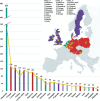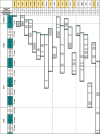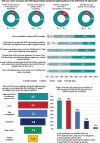The European TeleCheck-AF project on remote app-based management of atrial fibrillation during the COVID-19 pandemic: centre and patient experiences
- PMID: 33822029
- PMCID: PMC8083545
- DOI: 10.1093/europace/euab050
The European TeleCheck-AF project on remote app-based management of atrial fibrillation during the COVID-19 pandemic: centre and patient experiences
Abstract
Aims: TeleCheck-AF is a multicentre international project initiated to maintain care delivery for patients with atrial fibrillation (AF) during COVID-19 through teleconsultations supported by an on-demand photoplethysmography-based heart rate and rhythm monitoring app (FibriCheck®). We describe the characteristics, inclusion rates, and experiences from participating centres according the TeleCheck-AF infrastructure as well as characteristics and experiences from recruited patients.
Methods and results: Three surveys exploring centre characteristics (n = 25), centre experiences (n = 23), and patient experiences (n = 826) were completed. Self-reported patient characteristics were obtained from the app. Most centres were academic (64%) and specialized public cardiology/district hospitals (36%). Majority of the centres had AF outpatient clinics (64%) and only 36% had AF ablation clinics. The time required to start patient inclusion and total number of included patients in the project was comparable for centres experienced (56%) or inexperienced in mHealth use. Within 28 weeks, 1930 AF patients were recruited, mainly for remote AF control (31% of patients) and AF ablation follow-up (42%). Average inclusion rate was highest during the lockdown restrictions and reached a steady state at a lower level after easing the restrictions (188 vs. 52 weekly recruited patients). Majority (>80%) of the centres reported no problems during the implementation of the TeleCheck-AF approach. Recruited patients [median age 64 (55-71), 62% male] agreed that the FibriCheck® app was easy to use (94%).
Conclusion: Despite different health care settings and mobile health experiences, the TeleCheck-AF approach could be set up within an extremely short time and easily used in different European centres during COVID-19.
Keywords: Atrial fibrillation; COVID-19; Remote monitoring; TeleCheck-AF; Telemedicine; eHealth; mHealth.
© The Author(s) 2021. Published by Oxford University Press on behalf of the European Society of Cardiology.
Figures





Comment in
-
How simple ideas forged in the fire of adversity can change healthcare: telehealth for atrial fibrillation during the COVID 19 pandemic.Europace. 2021 Aug 6;23(8):1153-1154. doi: 10.1093/europace/euab072. Europace. 2021. PMID: 34293106 Free PMC article. No abstract available.
References
-
- Nieuwlaat R, Prins MH, Le Heuzey JY, Vardas PE, Aliot E, Santini M. et al.Prognosis, disease progression, and treatment of atrial fibrillation patients during 1 year: follow-up of the Euro Heart Survey on atrial fibrillation. Eur Heart J 2008;29:1181–9. - PubMed
-
- Hindricks G, Potpara T, Dagres N, Arbelo E, Bax JJ, Blomstrom-Lundqvist C. et al.2020 ESC Guidelines for the diagnosis and management of atrial fibrillation developed in collaboration with the European Association of Cardio-Thoracic Surgery (EACTS). Eur Heart J 2021;42:373–498. - PubMed
Publication types
MeSH terms
LinkOut - more resources
Full Text Sources
Other Literature Sources
Medical

